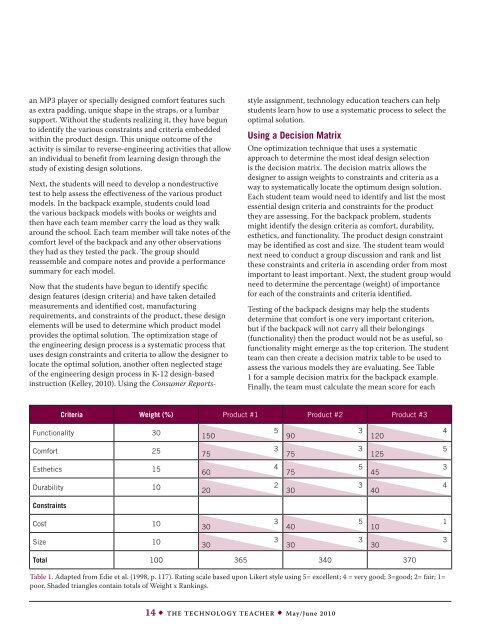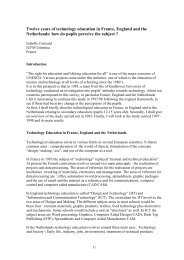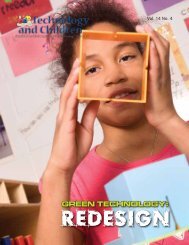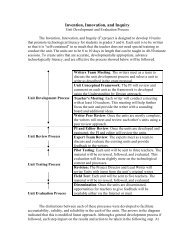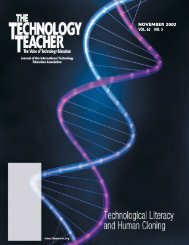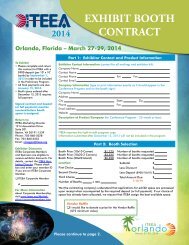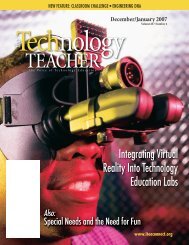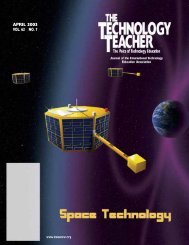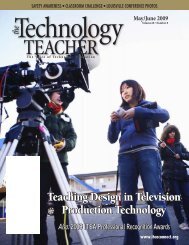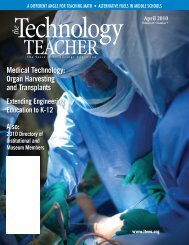May/June - Vol 69, No 8 - International Technology and Engineering ...
May/June - Vol 69, No 8 - International Technology and Engineering ...
May/June - Vol 69, No 8 - International Technology and Engineering ...
Create successful ePaper yourself
Turn your PDF publications into a flip-book with our unique Google optimized e-Paper software.
an MP3 player or specially designed comfort features such<br />
as extra padding, unique shape in the straps, or a lumbar<br />
support. Without the students realizing it, they have begun<br />
to identify the various constraints <strong>and</strong> criteria embedded<br />
within the product design. This unique outcome of the<br />
activity is similar to reverse-engineering activities that allow<br />
an individual to benefit from learning design through the<br />
study of existing design solutions.<br />
Next, the students will need to develop a nondestructive<br />
test to help assess the effectiveness of the various product<br />
models. In the backpack example, students could load<br />
the various backpack models with books or weights <strong>and</strong><br />
then have each team member carry the load as they walk<br />
around the school. Each team member will take notes of the<br />
comfort level of the backpack <strong>and</strong> any other observations<br />
they had as they tested the pack. The group should<br />
reassemble <strong>and</strong> compare notes <strong>and</strong> provide a performance<br />
summary for each model.<br />
<strong>No</strong>w that the students have begun to identify specific<br />
design features (design criteria) <strong>and</strong> have taken detailed<br />
measurements <strong>and</strong> identified cost, manufacturing<br />
requirements, <strong>and</strong> constraints of the product, these design<br />
elements will be used to determine which product model<br />
provides the optimal solution. The optimization stage of<br />
the engineering design process is a systematic process that<br />
uses design constraints <strong>and</strong> criteria to allow the designer to<br />
locate the optimal solution, another often neglected stage<br />
of the engineering design process in K-12 design-based<br />
instruction (Kelley, 2010). Using the Consumer Reportsstyle<br />
assignment, technology education teachers can help<br />
students learn how to use a systematic process to select the<br />
optimal solution.<br />
Using a Decision Matrix<br />
One optimization technique that uses a systematic<br />
approach to determine the most ideal design selection<br />
is the decision matrix. The decision matrix allows the<br />
designer to assign weights to constraints <strong>and</strong> criteria as a<br />
way to systematically locate the optimum design solution.<br />
Each student team would need to identify <strong>and</strong> list the most<br />
essential design criteria <strong>and</strong> constraints for the product<br />
they are assessing. For the backpack problem, students<br />
might identify the design criteria as comfort, durability,<br />
esthetics, <strong>and</strong> functionality. The product design constraint<br />
may be identified as cost <strong>and</strong> size. The student team would<br />
next need to conduct a group discussion <strong>and</strong> rank <strong>and</strong> list<br />
these constraints <strong>and</strong> criteria in ascending order from most<br />
important to least important. Next, the student group would<br />
need to determine the percentage (weight) of importance<br />
for each of the constraints <strong>and</strong> criteria identified.<br />
Testing of the backpack designs may help the students<br />
determine that comfort is one very important criterion,<br />
but if the backpack will not carry all their belongings<br />
(functionality) then the product would not be as useful, so<br />
functionality might emerge as the top criterion. The student<br />
team can then create a decision matrix table to be used to<br />
assess the various models they are evaluating. See Table<br />
1 for a sample decision matrix for the backpack example.<br />
Finally, the team must calculate the mean score for each<br />
Criteria Weight (%) Product #1 Product #2 Product #3<br />
Functionality 30<br />
Comfort 25<br />
Esthetics 15<br />
Durability 10<br />
150<br />
5<br />
90<br />
3<br />
120<br />
4<br />
75<br />
3<br />
75<br />
3<br />
125<br />
5<br />
60<br />
4<br />
75<br />
5<br />
45<br />
3<br />
20<br />
2<br />
30<br />
3<br />
40<br />
4<br />
Constraints<br />
Cost 10<br />
Size 10<br />
30<br />
3<br />
40<br />
5<br />
10<br />
1<br />
30<br />
3<br />
30<br />
3<br />
30<br />
3<br />
Total 100 365 340 370<br />
Table 1. Adapted from Edie et al. (1998, p. 117). Rating scale based upon Likert style using 5= excellent; 4 = very good; 3=good; 2= fair; 1=<br />
poor. Shaded triangles contain totals of Weight x Rankings.<br />
14 • The <strong>Technology</strong> Teacher • <strong>May</strong>/<strong>June</strong> 2010


